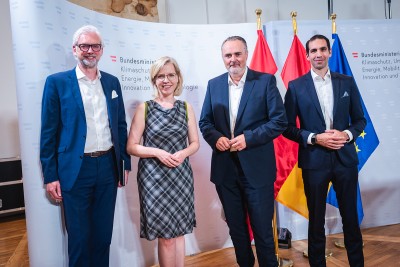Austria Launches One of the Largest Hydrogen Projects in Europe
An ambitious hydrogen project is currently being undertaken by Austria in order to reduce the country's reliance on foreign energy suppliers in the future. Austria's largest electrolyser will be built in Burgenland in the future. This will contribute to Austria's energy independence by producing green hydrogen in a sustainable manner.
 Michael Strugl, Leonore Gewessler, Hans Peter Doskozil and Stephan Sharma. / Picture: © BMK/Cajetan Perwein
Michael Strugl, Leonore Gewessler, Hans Peter Doskozil and Stephan Sharma. / Picture: © BMK/Cajetan Perwein
In order to be less dependent on foreign energy suppliers in the future, Austria is now initiating one of the most ambitious European hydrogen projects. To this end, Austria's largest electrolyser is to be built in Burgenland, Austria's southernmost province.
This will produce 40,000 tonnes of green hydrogen from 300 megawatts of wind and solar energy and thus make a sustainable contribution to Austria's energy independence.
In a joint press conference, Climate Protection Minister Leonore Gewessler, Provincial Governor Hans Peter Doskozil, Chairman of the Verbund Board Michael Strugl and Burgendland Energy CEO Stephan Sharma presented the joint plans.
Green hydrogen is an important step towards energy independence and climate neutrality, they unanimously emphasised.
The initiators of the project further explained that hydrogen is one of the most important building blocks on the way to a climate-neutral future, as it is a high-quality energy carrier that can be used in many ways.
These properties make it possible to promote decarbonisation, especially in industry, where fossil fuels often cannot be directly replaced by electricity. It could also play a role as storage in the future, as well as in niche applications in mobility.
The joint initiative of the two domestic energy companies is an important building block in the federal government's hydrogen strategy and an excellent signal, he said.
"We are currently feeling very clearly how dangerous our dependence on energy imports is. That is why we will focus more on domestic production of green hydrogen. Only a few weeks ago, we laid the foundation stone with our hydrogen strategy. Today we can already present a first project. This is an important and big step," says Climate Protection Minister Leonore Gewessler.
Aus 300 MW #Wind- und #Sonnenenergie werden im Vollausbau 40.000 Tonnen grüner #Wasserstoff produziert. Damit ist das Projekt auch im europäischen Vergleich eines der größten #Wasserstoffprojekte. (3/4) pic.twitter.com/HAVK8ChuK8
— Leonore Gewessler (@lgewessler) July 20, 2022
In order to achieve this ambitious goal, she said, it would take a joint effort on the part of all those involved, an acceleration of procedures and the courage to do pioneering work. This protects the climate, but is also an important step towards the necessary independence from gas from Russia.
As a pioneer in green hydrogen, cooperation partner Verbund, together with voestalpine and Siemens, has already commissioned Austria's first PEM electrolyser in 2019.
Green hydrogen is an essential pillar of the company's strategy. Electrolysers are technical devices that induce a chemical reaction, i.e. a conversion of substances, with the help of electric current.
Verbund CEO Michael Strugl is optimistic: "Europe is facing a turning point in the energy industry. Renewable energies are our only chance for decarbonisation and independence from fossil imports - but we also need green hydrogen as a gamechanger."
"Now is the chance to put Austria in a pioneering role. This joint project takes us a big step forward towards the energy future," he said.
By 2040, the demand for green hydrogen in Austria will be 4 to 5 times the current total demand. This demand will be met by increasing local production, but also by hydrogen imports.
Stephan Sharma, initiator and idea provider of the project, states: "Hydrogen is a crucial energy carrier of the future. Today we are in the biggest energy transformation since the invention of the steam engine. In a very short time, we will switch heating and mobility from fossil fuels to electricity. And that is good and right. Instead of burning fossil fuels, we can produce electricity with renewable energies and use it for our needs. For that gap where electricity is not an adequate substitute, cleanly produced hydrogen is an excellent product to replace oil and gas."
The plant, which Burgenland Energie and Verbund are jointly constructing in Burgenland, will be built in several stages. Thus, from 2026, 9,000 tonnes of green hydrogen will be produced from Burgenland's wind and solar energy per year. In the full expansion stage by 2030, there will be 40,000 tonnes of hydrogen per year for Austria, which will save us 400,000 tonnes of CO2 emissions per year.
BMK - Federal Ministry for Climate Action Environment Energy Mobility Innovation Technology



